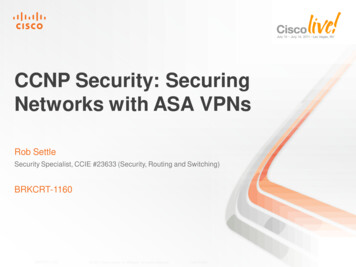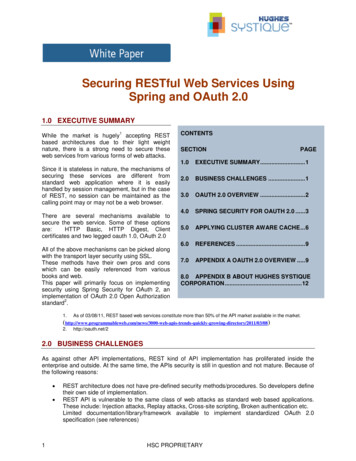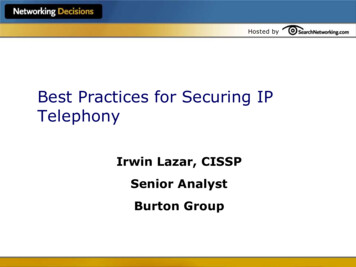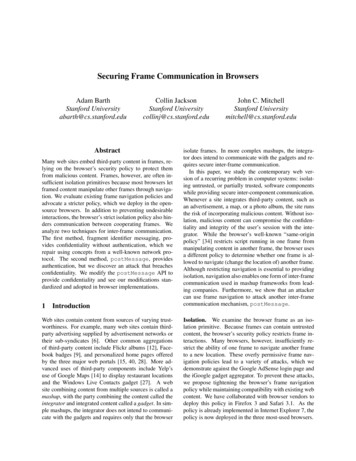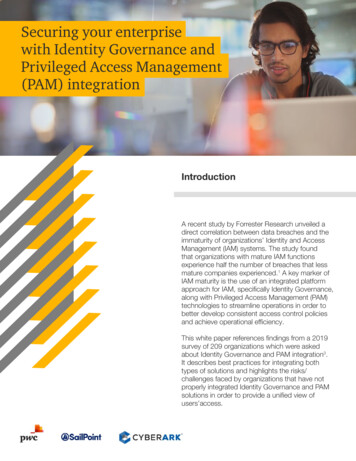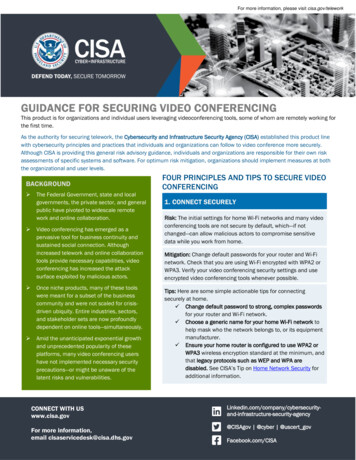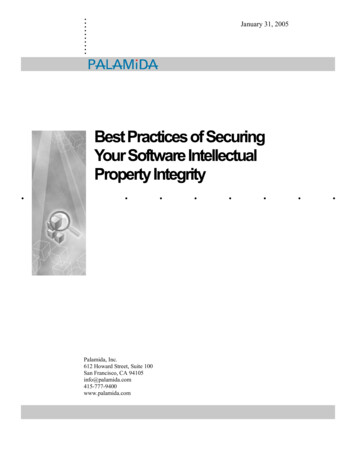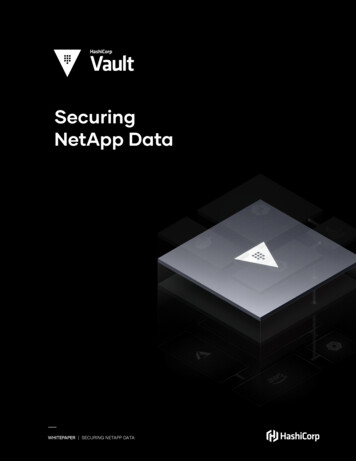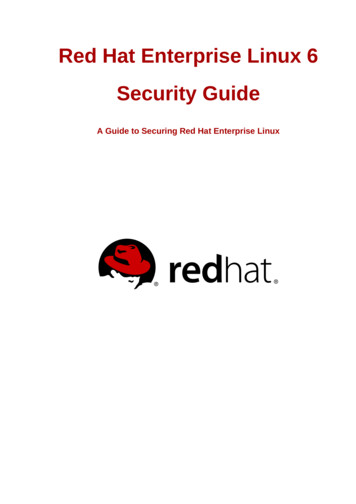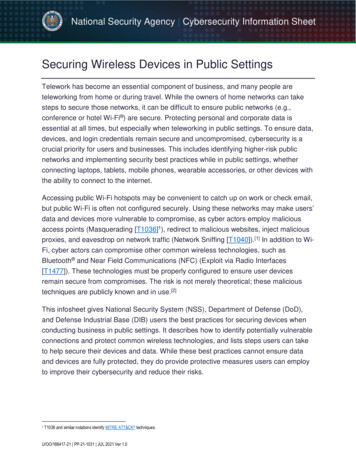
Transcription
National Security Agency Cybersecurity Information SheetSecuring Wireless Devices in Public SettingsTelework has become an essential component of business, and many people areteleworking from home or during travel. While the owners of home networks can takesteps to secure those networks, it can be difficult to ensure public networks (e.g.,conference or hotel Wi-Fi ) are secure. Protecting personal and corporate data isessential at all times, but especially when teleworking in public settings. To ensure data,devices, and login credentials remain secure and uncompromised, cybersecurity is acrucial priority for users and businesses. This includes identifying higher-risk publicnetworks and implementing security best practices while in public settings, whetherconnecting laptops, tablets, mobile phones, wearable accessories, or other devices withthe ability to connect to the internet.Accessing public Wi-Fi hotspots may be convenient to catch up on work or check email,but public Wi-Fi is often not configured securely. Using these networks may make users’data and devices more vulnerable to compromise, as cyber actors employ maliciousaccess points (Masquerading [T1036]1), redirect to malicious websites, inject maliciousproxies, and eavesdrop on network traffic (Network Sniffing [T1040]).[1] In addition to WiFi, cyber actors can compromise other common wireless technologies, such asBluetooth and Near Field Communications (NFC) (Exploit via Radio Interfaces[T1477]). These technologies must be properly configured to ensure user devicesremain secure from compromises. The risk is not merely theoretical; these malicioustechniques are publicly known and in use.[2]This infosheet gives National Security System (NSS), Department of Defense (DoD),and Defense Industrial Base (DIB) users the best practices for securing devices whenconducting business in public settings. It describes how to identify potentially vulnerableconnections and protect common wireless technologies, and lists steps users can taketo help secure their devices and data. While these best practices cannot ensure dataand devices are fully protected, they do provide protective measures users can employto improve their cybersecurity and reduce their risks.1T1036 and similar notations identify MITRE ATT&CK techniques.U/OO/166417-21 PP-21-1031 JUL 2021 Ver 1.0
NSA Securing Wireless Devices in Public SettingsBest practices for securing wireless devicesWhile technology settings and business controls may help keep security measures upto-date, users should also be aware of the potential threats from connecting to publiclyavailable Internet and take appropriate precautions. Before conducting businessremotely or in public settings users should obtain explicit authorization from theirorganization to do so. Organizations may decide to require that users working like thisadopt best practices such as the ones detailed here. The information that follows maybe used to better protect users, devices, and data while teleworking.Public Wi-FiAvoid connecting to public Wi-Fi, when possible, as there is an increased risk whenusing public Wi-Fi networks. Use a corporate or personal Wi-Fi hotspot with strongauthentication and encryption whenever possible, as it will be more secure.If users choose to connect to public Wi-Fi, they must take precautions. Data sent overpublic Wi-Fi—especially open public Wi-Fi that does not require a password to access—is vulnerable to theft or manipulation. Even if a public Wi-Fi network requires apassword, it might not encrypt traffic going over it. If the Wi-Fi network does encrypt thedata, malicious actors can decrypt it if they know the pre-shared key (Eavesdrop onInsecure Network Communication [T1439]). A malicious actor can also sometimescoerce the network into using insecure protocols or obsolete encryption algorithms(Downgrade to Insecure Protocols [T1466]).[3] Additionally, a malicious actor can set upa fake access point, also known as an evil twin, to mimic the nearby expected public WiFi,[2] resulting in that actor having access to all data sent over the network. Unencryptednetwork traffic or traffic that is easily decrypted can be captured using open-sourcetools, exposing sensitive data. This includes, but is not limited to, personal andcorporate login credentials (Network Sniffing [T1040]) that can lead directly to additionalcompromises.[4]If connecting to a public Wi-Fi network, NSA strongly advises using a personal orcorporate-provided virtual private network (VPN) to encrypt the traffic.[1],[3-6] In addition,users should incorporate secure browsing methods, such as only accessing websitesthat use Hypertext Transfer Protocol Secure (HTTPS). This is usually indicated by theURL beginning with “https://” or a lock symbol. These methods, as well as the oneslisted in the “Do’s and Don’ts” section, will aid users in better protecting their informationfrom Wi-Fi snooping (Network Sniffing [T1040]), man-in-the-middle techniques (Man-inthe-Middle [T1557]), server masquerades used to capture password hashes (such asU/OO/166417-21 PP-21-1031 JUL 2021 Ver 1.02
NSA Securing Wireless Devices in Public Settingsthe Responder tool) (Man-in-the-Middle: LLMNR/NBT-NS Poisoning and SMB Relay[T1557.001]), and evil twin mimics.BluetoothBluetooth technology transmits data wirelessly between devices within short distances.This feature is very convenient in private (i.e., non-public settings). However, keeping adevice’s Bluetooth feature enabled in a public setting can pose a cybersecurity risk.Malicious actors can scan for active Bluetooth signals, potentially giving them access toinformation about the targeted device. They can then leverage that information tocompromise the device.[1] Other Bluetooth compromise techniques posing a cyberthreat in public settings include Bluejacking, Bluesnarfing, and Bluebugging to send,collect, or manipulate data and services on the device (Exploit via Radio Interfaces[T1477]). Additionally, the publicly released Bluetooth exploit, Blueborne, demonstratesthat Bluetooth vulnerabilities can allow malicious actors complete control over a user’sBluetooth device. This could enable access to corporate data and networks.NFCNFC offers the benefit of contactless payments and other close device-to-device datatransfers. As with any network protocol, there may be NFC vulnerabilities that can beexploited (Exploit via Radio Interfaces [T1477]). Due to NFC range limitations,opportunities to exploit vulnerabilities may be limited. However, NSA advises beingaware of security risks with the technology and if possible, disable the function when itis not in use.U/OO/166417-21 PP-21-1031 JUL 2021 Ver 1.03
NSA Securing Wireless Devices in Public SettingsDo’s and Don’tsComplete security is never guaranteed, but to protect their devices and data in publicsettings when teleworking, NSS, DoD, and DIB users should adhere to the followingDo’s and Don’ts:DO’SDON’TSFOR WIRELESS DEVICESAll DevicesAll Devices Keep software and applicationsupdated with the latest patches.[3],[8],[9] Do not leave them unattended inpublic settings.[1],[6] Use anti-virus/anti-malware software(if applicable). Use multi-factor authentication (MFA)whenever possible.[1],[3-6],[9]Do not use personal information inthe names of the devices (i.e.,John/Jane Smith’s Computer). MFA can assist in account/devicesecurity to defend againstpassword hash captures. Reboot regularly, especially for mobilephones after using untrusted Wi-Fi.[6]In Addition: For Laptops Enable firewalls to restrict inbound andoutbound connections byapplication.[5],[6]In Addition: For Windows Laptops Disable Link-Local Multicast NameResolution (LLMNR) if applicable.[10] Disable Netbios Name Service (NBTNS).[10]U/OO/166417-21 PP-21-1031 JUL 2021 Ver 1.04
NSA Securing Wireless Devices in Public Settings Configure Web-Proxy AutodiscoveryProtocol (WPAD) to use only corporateproxy servers.[11],[12] In conjunction, disable AutodetectProxy Settings.DO’SDON’TSFOR PUBLIC WI-FIAll DevicesAll Devices Connect to a personal/corporatewireless hotspot with strongauthentication and encryption ifpossible. Do not connect to open Wi-Fihotspots.[1],[3–6] Do not enter most sensitive accountpasswords on sites/applications. Disable Wi-Fi when not in use.[6] Ensure the device is connecting to thecorrect network.Avoid accessing personal data (e.g.,bank accounts, medical, etc.).[1] Do not have sensitiveconversations.[6] Avoid online shopping or financialtransactions.[1] Do not click unexpected links, Disable Wi-Fi network autoconnect.[1],[3],[6] If connecting to public Wi-Fi isnecessary: Only connect to secure public WiFi.[1],[5]o This usually requires apassword or other forms ofauthentication, limiting whocan connect.o Only connect to networks withWPA2-encryption at aattachments, or pop-ups.[6]In Addition: For Laptops Do not set public Wi-Fi networks tobe trusted networks. Do not browse the Internet using theadministrator’s account for thedevice.minimum2.2Users can find this information in the Device Settings under Network Properties or Network Details in macOS .U/OO/166417-21 PP-21-1031 JUL 2021 Ver 1.05
NSA Securing Wireless Devices in Public Settings Log out of the public Wi-Fi networkand “Forget” the access point whenfinished using it. Delete unused Wi-Fi networks.[6] Use an IPsec VPN.[1],[3-6] Use HTTPS browsingprotocols.[1],[5] Only browse to or use necessarywebsites and accounts.In Addition: For Laptops Turn off the device file and printersharing on public networks.[3],[5] Use virtual machines (VMs) for anadditional layer of security (if feasible)to contain drivers (e.g., Wi-Fi driver)and applications (e.g., web browsers)that process untrusted data fromexternal sources.[13] The VM limits compromisedadversarial activity. Ifcompromised, the VM can bediscarded.DO’SDON’TSFOR BLUETOOTHAll DevicesAll Devices Monitor Bluetooth connections byperiodically checking what devices arecurrently connected to the device.U/OO/166417-21 PP-21-1031 JUL 2021 Ver 1.0Do not use Bluetooth tocommunicate passwords or sensitivedata.6
NSA Securing Wireless Devices in Public Settings Disable the Bluetooth feature when itis not being used.[6] Ensure the device is not left indiscovery mode when Bluetooth isactivated and discovery is notneeded.[1],[6] Use an allowlist or denylist of Do not accept non-initiated pairingattempts.applications that can use the device’sBluetooth.DO’SDON’TSFOR NFCAll DevicesAll Devices Do not bring devices near otherunknown electronic devices. (Thiscan trigger automaticcommunication.) Do not use NFC to communicatepasswords or sensitive data.Disable NFC feature when not needed(if possible).Users should consider additional security measures, including limiting/disabling devicelocation features, using strong device passwords, and only using trusted deviceaccessories, such as original charging cords.[6]Telework safelyThe methods used to compromise devices and data are constantly evolving. Astelework becomes more common, users are more frequently bringing themselves andtheir data into unsecured settings and risking exposure. By following the guidance inthis infosheet and related guidance, users can identify potential threats and put bestpractices into action when teleworking in public settings. U/OO/166417-21 PP-21-1031 JUL 2021 Ver 1.07
NSA Securing Wireless Devices in Public SettingsWorks cited[1] Johansen, A.G. (2018), The do’s and don’ts of using public Wi-Fi. Available -dos-and-donts-of-using-public-wi-fi.html[2] CBS Boston, (2018). Hacker Demonstrates Security Risk of Free Public Wi-Fi. Available at:https://www.youtube.com/watch?v 1OVTmrXGHyU/[3] Johansen, A.G. (2020), Public Wi-Fi Security: Why public Wi-Fi is vulnerable to attack. Availableat: ble-to-attack-and-how-to-stay-safe.html[4] Hougen, A. (2020), Dangers of Public Wi-Fi: What you need to know in 2020. Available fi/[5] Griffith, E. (2020), 14 Tips for public Wi-Fi hotspot security. Available -wi-fi-hotspot-security/[6] NSA (2020). Mobile Device Best Practices. Available 0/-1/-1/0/Mobile Device UOO15548820 v1 1.PDF[7] Cynet (2021). LLMNR & NBT-NS Poisoning and Credential Access Using Responder. Availableat: esponder/[8] NSA (2019). Update and Upgrade Software Immediately. Available 9/-1/-1/0/UPDATE AND UPGRADESOFTWARE IMMEDIATELY.PDF[9] NSA (2019). NSA’s Top Ten Cybersecurity Mitigations Strategies. Available 6/-1/-1/0/DDD-190716-666-071.PDF[10] California Community Colleges (2021). Link Local Multicast Name Resolution (LLMNR0 andNetBIOS Name Service (NBT-NS). Available at -ns/[11] CISA (2016). WPAD Name Collision Vulnerability. Available at https://uscert.cisa.gov/ncas/alerts/TA16-144A[12] Active Directory Security (2016). Securing Windows Workstations: Developing Secure Baseline.Available at https://adsecurity.org/?p 3299[13] VMware (2020). Creating Virtual Machines in VMware Workstation. Available laimer of endorsementThe information and opinions contained in this document are provided "as is" and without any warranties or guarantees. Referenceherein to any specific commercial products, process, or service by trade name, trademark, manufacturer, or otherwise, does notconstitute or imply its endorsement, recommendation, or favoring by the United States Government, and this guidance shall not beused for advertising or product endorsement purposes.PurposeThis document was developed in furtherance of NSA’s cybersecurity missions, including its responsibilities to identify anddisseminate threats to National Security Systems, Department of Defense, and Defense Industrial Base information systems, and todevelop and issue cybersecurity specifications and mitigations. This information may be shared broadly to reach all appropriatestakeholders.TrademarksWi-Fi is a registered trademark of Wi-Fi Alliance. Bluetooth is a registered trademark of Bluetooth SIG, Inc. VMware is aregistered trademark of VMware, Inc. MITRE ATT&CK is a registered trademark of The MITRE Corporation. macOS is aregistered trademark of Apple Inc. in the U.S. and other countries and regions. Wi-Fi is a registered trademark of Wi-Fi Alliance.ContactClient Requirements / General Inquiries: Cybersecurity Requirements Center, 410-854-4200, Cybersecurity Requests@nsa.govMedia Inquiries / Press Desk: Media Relations, 443-634-0721, MediaRelations@nsa.govU/OO/166417-21 PP-21-1031 JUL 2021 Ver 1.08
Jul 29, 2021 · National Security Agency Cybersecurity Information Sheet Securing Wireless Devices in Public Settings Telework has become an essential component of business, and many people are teleworking from home or during travel. While the owners of home networks can take steps to secure those netwo

